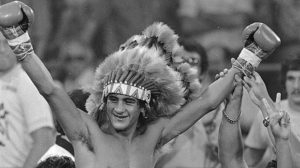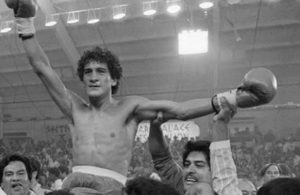Salvador Sanchez – Skills/ Weaknesses Analysis

Mexican Salvador Sanchez was one of the most skill fighters in history
SALVADOR SANCHEZ SKILLS
The great Mexican Salvador Sanchez, was one of the most complete fighters to have set foot in the ring. Sanchez had no more than 10 amateur contests, and turned professional at the age of 16. Within 7 years, the young fighter worked his way to the championship, defended it an impressive 9 times by the age of 23, before he was tragically killed in a car accident. Despite his young age, Sanchez dominated the featherweight division with an iron fist, but an even more impressive, was the intelligence that he showed as he done so. Let’s break down some of the skills which Sanchez utilised to imprint his name in boxing history.
Note: Some of the following skills detailed are in the above video (Art of Boxing: Salvador Sanchez – Skills & Weaknesses. The relevant time points in the video that correspond with the text will be in brackets.
Footwork (00.23- 1.30)
Possibly the most important aspect Sanchez’s fight game was his stability and balance in his feet. This was essentially the reason he was such a good counterpuncher. With good balance, a fighter is able to transfer his weight more effectively from the back foot to the front foot. With good balance and control of his own momentum, Sanchez was able to step in and out of range with great self-efficacy.
Sanchez achieved efficient footwork by maintaining distance between his two feet, and keeping his knees bent, so that he can easily push off to move in different directions. Sanchez also stayed mobile, by consistently bouncing. While very simple, this one thing can be extremely effective, due to the fact that it is easy move something (in this case, the body) if it already has moving momentum, as opposed to if it is still. It’s one of the reasons that Sanchez was so quick to react defensively and offensively.
Low Angle Punches (1.39-2.15)
A favourite of Sanchez, was to dip down and fire a punch from a low angle, especially with his power hand. Made easier by his continuous bounce, Sanchez would bend, or squat down, and spring up with a punch, catching his opponent by total surprise. Instinctively, when an opponent dips down, you expect he may be throwing a body punch, causing you to lower guard or bringing your focus down. This creates a clear opening for a punch to the head, which is also difficult to track once you do realise a head punch is incoming. This is always the case with punches coming from low angles, because of the upwards angled trajectory of the punch.
Sanchez also established patterns by dipping to his left and coming up with his left, and vice versa. He would then break the pattern by dipping to his left, but throwing the left and vice versa. Sanchez had great success against fighters who held their gloves low, due to the fact that they usually rely on their opponent to display the usual cues that alert them to incoming punches, but Sanchez would stifle their ability to read him by his unorthodox dips and feints.
Defence (2.32-3.44)
Sanchez occasionally did get hit, which is to be expected in the sport of boxing. The difference between the elite and which is to be expected in the sport of boxing. The difference between the elite and good, is that they minimise the opportunities for an opponent to establish patterns of offence. Sanchez utterly shut out his opponent’s offence, limiting them to few punches, and at irregular points. Sanchez done this by combining multiple methods of defence at the same time, rather than only one, meaning Sanchez’s opponent’s could never establish a consistency of dominance against him. For example, instead of just moving his head, he would move his head, change his position via the feet, and parrying punches.
Forearm defence (3.46- 4.25)
A defensive favourite of Sanchez, was to use his forearm as a large barrier against opponent punches, in much the same way that a roman soldier would use a shield to create barrier between him and the opposing shoulders. Sanchez would bring his forearm up, bringing his elbow as high as his chin, to block punches, leaving little chance of it even coming in close vicinity to his face.
Always the keen counterpuncher, Sanchez would counter off of the forearm block. Bending his back leg as his opponent’s punch landed on his forearm, to generate power for the counter. Leaning back when blocking the punch is a feint in itself, as the opponent initially believes that it is a purely defensive action, leaving opponents surprised when it is was followed through with a punch. Starting the counterpunch as early as possible was crucial in ensuring quickness to the target. Quickness itself is crucial because of the fact that forearm blocking exposes the abdominal area, and could be taken advantage of if Sanchez was not quick with his counter.
Elusiveness (4.26- 6.00)
Sanchez was incredibly hard to hit, even in the situation where a fighter is typically at his most vulnerable: when he himself punching. Salvador would move his head after punching, meaning it was quite rare that he was counterpunched by his opponents. Even in the midst of a flurry, or a violent and pacey exchange, Sanchez would remain a moving target to make it almost impossible for his opponent to track him.
Due to his own height, most of Sanchez’s opponents were shorter than him, meaning that the primary game plan was to pressure Sanchez and fight in close quarters, or at least the mid range. But Sanchez was just as hard to find in close, as much as he was outside. He had an ability to slip, roll, slide and catch punches on the inside, that is a truly rare sight to see. One way he made this possible, was by making himself a very small target. So for example, when inside, Sanchez would lower his stance and bend slightly forward, forcing his opponent to make more physical adjustments to find space, and find the target. Leaning into his opponent also shortened the punch variety of his opponent, especially when he placed himself at certain angles and in certain positions. For example, placing himself on the right of his opponent in close may smother his opponent’s right and instinctively encourage them to use their left hook.
Weaknesses (7.05- 7.45)
Sanchez was a fighter who often liked to drop his lead hand when punching, especially after he threw a jab. This meant that opponents could have success landing right hands on Sanchez. Sanchez was particularly vulnerable when he threw his weight onto his front foot and leaned forward as the waist. This would cause him to lose control of his balance, and rooted on the spot temporarily, opening the window for his opponent’s right hand over his guard.
Dropping the lead hand isn’t actually the mistake. Rather, the mistake Sanchez made was that he didn’t replace the deficiency in his defence with a replacement. Using the shoulders, or head movement are sufficient defensive replacements. Simply put, Sanchez lacked some defensive awareness in this area. As the years went by, in the last few defences he made, Sanchez improved in this area, and wouldn’t commit as much weight into his jabs as he did before.
Sanchez could also be backed up quite easily. This is more a speculative weakness, rather than a outright one, due to the fact that no opponent took advantage of this enough to provide us with concrete evidence that it would’ve led to him being dominated in a contest. So although Sanchez was backed up pretty easily, you get the sense that, for the most part, it was partially out of choice rather than against his will.

Sanchez celebrates defeating Wilfredo Gomez
Conclusion
Salvador Sanchez ranks among the greatest in history, despite his career ending at the age of 23, as a result of his tragic death in 1982. Maybe the most impressive thing, is that being so young when he captured the featherweight title, as good as he was, Sanchez was still improving, and it’s amazing to think of the greatness he would have grown into. In any conversation concerning the legends of the sport, Salvador Sanchez’s name has to be included.
The legendary Willie Pep once said of Salvdaor Sanchez, ‘I’m glad he wasn’t around in my era.’ Sanchez, as young as he was abundantly skilled, and the very thought of Sanchez competing against the likes of Willie Pep, and other great featherweights is extremely mouth-watering. How well would he have done? One can only wonder.
Salvador Sanchez Highlights

Leave a Reply
Be the First to Comment!